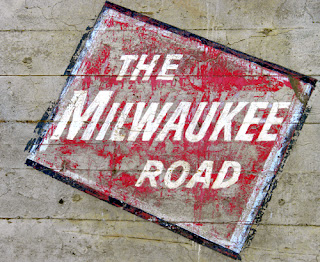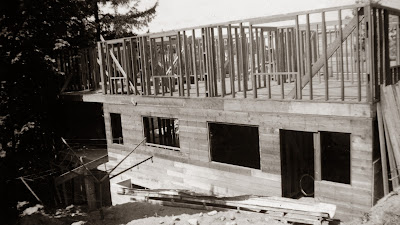Katheryn Dorothy Frederick, is a 2nd cousin once removed. She was the daughter of Charles Friedrich's youngest son and Arthur's cousin, Ernst Alexander Friedrich ("the fighting parson" about whom I may be writing later) and his wife, Nina Vivian Hubbell (to whom the famous telescope seems to be distantly, if at all, related).
She's rather famous, which is unusual for our family, and her name appears in several biographical sketches of leaders of the women's rights movement. Considering our family's general anonymity, it's perhaps fitting that she was known as "The Quiet Feminist".
 |
| Kathryn Dorothy Frederick's senior class portrait at the University of Wisconsin, 1941 |
Here's one of her biographies I found online:
Kathryn Clarenbach, women's rights activist and educator, was born Kathryn Dorothy Frederick in Sparta, Wisconsin, on October 7th, 1920. Her father, Alexander Ernst Frederick, a Methodist minister, attorney, and state probation officer, served in the Wisconsin State Assembly from 1913 to 1916.
Her mother, Nina Vivian Hubbell, a high school graduate and a teacher before marriage, became a member of the local school board in the early 1920s. Kathryn Frederick and her three brothers were thus raised by parents who had both served in public office. She graduated from Sparta High School at the age of sixteen as the valedictorian of her class. Although her father urged her to major in education during college, she earned degrees in political science (B.A. 1941, M.A. 1942, Ph.D. 1946) from the University of Wisconsin at Madison, where, as she recalled, there were no female faculty in her department at the time. From 1942 to 1944 she worked in civil service for the War Production Board in Washington, D.C.
In 1946 she married Henry G. Clarenbach, a fellow graduate student in political science, and during the postwar years she focused on raising a family, as did many white middle-class women during that era; yet she was also actively involved in political and civic work. Kathryn Clarenbach first taught at Purdue University but left to join her husband, who was enrolled in a Ph.D. program at Columbia University in New York City, where the couple also worked on the 1948 presidential campaign of the Progressive candidate Henry Wallace. When her husband found full-time teaching positions in Michigan, Missouri, and New York, Clarenbach went with him, often teaching part time and engaging in volunteer work while raising three children born between 1949 and 1957. In Missouri during the 1950s she became a state board member of the League of Women Voters. The family eventually returned to Madison, Wisconsin, where she taught at Edgewood College in 1961 and served on the board of trustees of Alverno College, a Catholic women's college in Milwaukee.
By 1962 Clarenbach was hired to develop a program in continuing education for women at the University of Wisconsin-Extension, and it was then that she began to fully dedicate herself to feminist goals. She initiated extension courses for women who sought higher education and employment outside the home during an era when women's roles were still highly restricted. At a 1963 conference on professional opportunities for women, she met Esther Peterson, the director of the Women's Bureau in the U.S. Department of Labor, who had helped convince John F. Kennedy to establish the President's Commission on the Status of Women in 1961. Clarenbach then worked with Peterson and state women's organizations to persuade Governor John Reynolds to authorize, by 1964, the Wisconsin Commission on the Status of Women, which became the twenty-fifth of fifty such state commissions created during the 1960s. Clarenbach was appointed as the first chair of Wisconsin's commission, a position she held from 1964 to 1969 and again from 1971 to 1979. As chair, Clarenbach helped strengthen a network of activists--including women from labor unions, the professions, women's clubs, and civil rights organizations--in the effort to change state laws that discriminated based on sex. Under her leadership the commission eventually influenced new legislation in areas such as marital property, sexual assault, divorce, and pay equity.
Building on her early state-level experience, Clarenbach soon played a leading role in the emergence of a national women's movement. At the third national conference of state commissions on the status of women in 1966, Clarenbach and other conference attendees protested the failure of the federal government to enforce Title VII of the 1964 Civil Rights Act, specifically its provisions against sex discrimination in employment. When their concerns were dismissed Clarenbach and many other activists, including the writer Betty Friedan, the attorney Pauli Murray, and the labor organizer Dorothy Haener, formed the National Organization for Women (NOW) in 1966 as an independent advocacy group, which successfully launched significant legal challenges to gender bias.
 |
| Kathryn Frederick Clarenbach (left) was a founding member of the National Organization of Women (NOW) |
As the chair of NOW's board, Clarenbach's skills in organizing and coalition building were instrumental, although Friedan, as NOW's president, attracted more media attention due to her celebrity as the author of The Feminine Mystique. Clarenbach recalled that her interactions with other NOW members convinced her to formally support the legalization of abortion, which NOW advocated beginning in 1967. Clarenbach and other members initially resisted including lesbian rights as part of NOW's agenda, and the organization did not officially endorse the issue until 1971, after she had stepped down as chair, although she eventually expressed support. She chaired NOW's board from 1966 to 1970 and later served as president of NOW's Legal Defense and Education Fund.
Clarenbach made other significant contributions to the national-level women's movement. In 1971 she was a founding organizer of the National Women's Political Caucus, along with the journalist Gloria Steinem and the congresswomen Bella Abzug and Shirley Chisholm, in the effort to increase the number of women in elected and appointed office. From 1970 to 1972 Clarenbach served as the first president of the National Association of Commissions for Women and helped prepare a handbook for commission members across the country, including advice on influencing the legislative process. She also served as deputy coordinator of the National Women's Conference in Houston, Texas, in 1977 in observance of International Women's Year.
Despite a growing backlash against the women's movement by the late 1970s, Clarenbach maintained her optimism and activism in the ongoing struggle for women's rights. After Governor Lee Dreyfus disbanded the Wisconsin Commission on the Status of Women in 1979, Clarenbach helped lead efforts to establish the Wisconsin Women's Council, a government entity that continued the work of the prior state commission beginning in 1983. She was an appointed member of that council for the rest of the decade and a professor at the University of Wisconsin-Extension until her retirement in 1988.
 |
| Kathryn Clarenbach, Professor of political science, University of Wisconsin |
The U.S. senator Russell Feingold, who had served as a state senator with Clarenbach on the Wisconsin Women's Council, later declared regarding her long history of activism: "[In] the fight for women's equality she was a pioneer, an architect, a leader, and an inspiration to thousands" (Congressional Record, 10 March 1994). Clarenbach's efforts to create change through commission work, NOW, and the women's movement as a whole helped American women make effective strides toward equality. She died in Madison, Wisconsin, on March 4th, 1994
Clarenbach's papers are housed in the archives of the University of Wisconsin at Madison, where her extensive oral history is also available online. Clarenbach contributed to several publications that grew out of state commission studies, such as Wisconsin Women and the Law (1989). She co-edited, with Edward L. Kamarck, The Green Stubborn Bud: Women's Culture at Century's Close (1987), which includes an introduction by Betty Friedan. Accounts of Clarenbach's activism at both the state and national level can be found in Gerda Lerner, Living with History/Making Social Change (2009), and Ruth Rosen, The World Split Open: How the Modern Women's Movement Changed America (2000). Clarenbach's early efforts on behalf of women's rights and her later influence on the women's movement are explored by Kathleen Laughlin, "Kathryn Clarenbach and the Wisconsin Commission on the Status of Women," Women and Social Movements in the United States 13, no. 2 (Sept. 2009). An obituary appeared in the New York Times, 10 Mar. 1994.
Carol F. Cini
http://www.anb.org/articles/15/15-01353.html;
American National Biography Online April 2014.
Copyright © 2014 American Council of Learned Societies. Published by Oxford University Press. All rights reserved. Privacy Policy.





















































